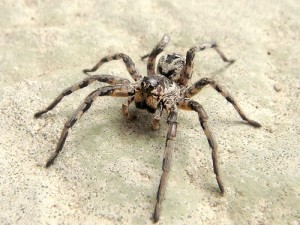Three and even more cheers for the level-headed journalists of India! who took that crazy spider story in Assam and dragged it into the cold light of day. You might have read those tales about big, huge, ENORMOUS dark-colored spiders being spotted in large numbers where they hadn’t before. Biting people, disrespecting cultural festivals, sending a few people to an early grave. First stories indicated they were giant (photos indicate otherwise) or called them “tarantulas” (again, photos are unclear), and cooked up a stew of overreaction seasoned with muddy facts.
No U.S. news outlets parachuted into the spider zone, so who knows what the arachnids would have done when confronted by Anderson Cooper and his accusing baby blues. So all we heard at first from this remove were tales from an echo chamber. Given the way these stories usually play out, how delightful to see how aggressively the Indian media smacked down the misinformation:
No evidence of spider swarms. Two people who died were swiftly cremated and evidence indicates one was bitten by a snake, and the other might have had an adverse reaction to the folk treatment inflicted on him. Arachnologists identified the supposed baddy as a common enough spider, not medically significant. The government even handed out pamphlets urging people not to panic, and pointing out that any “aggressiveness” on the spiders’ part was probably due to their being more noticeable at breeding time while on their nuptial stroll. A handful of people reliably reported as suffering spider bites (“I picked it up,” one admitted to the camera) were simply treated and released.
I liked the coverage on one website dedicated to covering “the marginalized areas of India.” TwoCircles.net pointed out that frightened people were killing spiders on sight, which was likely to harm the ecosystem. That’s a germane point your average breathless rumormonger rarely makes. Wipe out spiders and you’ll give free rein to crop pests, malaria-carrying mosquitoes, and who knows what other invertebrates and nasties.
(That site wants to be a “voice of sanity” for regions where good reporting is hard to find. Not perfectly objective or comprehensive, but a source of reliable information for intelligent decision-making. Wow. Missed the Web 2.0 version of online news in a big way, didn’t they?)
The India spider panic began more than a month ago, and I’d call it a Rorschach test for spider phobia if the term “Rorschach test for . . .” weren’t so overused and abused. (Same with “tabula rasa.”) Let’s just call it a great example of how spider fear can amplify and twist stories, and keep skepticism at arm’s length because when you’re talking about spiders, of course they’d do exactly that, wouldn’t they? The Times of India, which unlike its compatriots did not acquit itself well, even used the phrase “eight-legged freaks.”
And, oh god. One guy thinks spider swarms mean Gaia is fighting back. A blogger on NPR confidently asserted: “Assram state doesn’t have any poisonous spiders.” Uh, Assram? No venomous spiders? What do the spiders of Assam inject, Sunny Delight?
The crack news team at the Long Island Press illustrated their story with a picture of a fake spider from the “Harry Potter and the Chamber of Secrets” movie. Note to crack news team: spiders don’t scowl.
Meanwhile, HuffPo thinks there are vampire spiders.

Mamma mia, if it's-a not-a one-a stereotype, it's another! Whattaya gonna do.(Lycosa tarantula photo © J. Coelho, Creative Commons)
Spider hysteria has been kind of quiet lately. The Assam story echoes the folk fears that inspired the tarantella, the dance craze based on the belief that one had to boogie down and shimmy out the venom of the field spider that inspired the word “tarantula” (the spiders of Taranto, Italy, were probably not tarantulas but wolf spiders). I bet the tarantella has launched a thousand dissertations about medicine, mental health, and bacchanalian behavior. I only note that a spider—not an ant, not a bee, not a beetle, not even a rabid dog—kindled such a strange belief. Ancient or medieval or modern, people are always quick to tremble over the small dangers presented by spiders, even when they should be worrying about the large dangers of MRSA or viruses or much bigger animals with much bigger teeth. Or, if you live in Assam, cobras.
Also I think of those cohorts of schoolkids (typically girls) who develop strange speech patterns or tics or bruises en masse, blaming a purported toxic dump or a funny smell or a locally defamed creepy animal, only to miraculously recover. Watch for a fifth-grade class somewhere to be pursued by an army of recluses with a sudden appetite for ankles. And squeeeee! . . . off they go.
The Assam spiders surely were there all along, minding their own business in the woods and fields, until somebody trod on a few burrows or tipped over the wrong hollow log. Poke ’em with a stick and they display “aggressive behavior” toward the huge mammal that can crush out their life. Wouldn’t you?